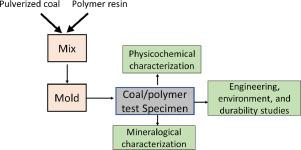Resources, Conservation and Recycling ( IF 13.2 ) Pub Date : 2021-06-28 , DOI: 10.1016/j.resconrec.2021.105756 Orevaoghene Eterigho-Ikelegbe , Kelvin O. Yoro , Samson Bada

|
There is rapidly growing interest in non-energy coal applications. In addition, the demand for non-traditional specialized materials is on the rise. Therefore, this review systematically presents cutting-edge updates on the development of polymer composites using coal as a filler feedstock. The review begins by exploring the polymeric nature and macromolecular structure of coal. The study then reviews the results of published experimental studies relating to the use of coal as a filler in polymeric composites. Previous studies have demonstrated that coal can serve as a filler to extend the use and processing of polymer materials. Based on the articles reviewed, the content of coal, the structure of the coal, and the interfacial bonding between coal particles and the polymer matrix are the main factors that influence the mechanical performance of the final coal/polymer composite material. Not to mention, coupling agents could be introduced to alter the surface of the coal particles as a strategy to increase the compatibility between coal and polymer and ultimately the composite performance. However, further studies involving the use of modeling and simulation capable of predicting the influence of processing parameters on the overall performance of the final composites are necessary. More positive results demonstrating the technical feasibility and sustainable utilization of coal as a filler in polymer composites production beyond the laboratory scale could pave the way for its large-scale applications.
中文翻译:

煤作为聚合物复合材料的填料:综述
人们对非能源煤炭应用的兴趣迅速增长。此外,对非传统专用材料的需求正在上升。因此,本综述系统地介绍了使用煤作为填料原料开发聚合物复合材料的前沿更新。这篇综述首先探讨了煤的聚合性质和大分子结构。然后,该研究回顾了已发表的有关使用煤作为聚合物复合材料填料的实验研究的结果。先前的研究表明,煤可以作为填料来扩展聚合物材料的使用和加工。根据评论文章,煤的含量,煤的结构,煤颗粒与聚合物基体之间的界面结合是影响最终煤/聚合物复合材料力学性能的主要因素。更不用说,可以引入偶联剂来改变煤颗粒的表面,作为提高煤与聚合物之间相容性并最终提高复合性能的策略。然而,还需要进一步研究,包括使用能够预测加工参数对最终复合材料整体性能的影响的建模和模拟。更积极的结果证明了煤作为超出实验室规模的聚合物复合材料生产中的填料的技术可行性和可持续利用,可以为其大规模应用铺平道路。更不用说,可以引入偶联剂来改变煤颗粒的表面,作为提高煤与聚合物之间相容性并最终提高复合性能的策略。然而,还需要进一步研究,包括使用能够预测加工参数对最终复合材料整体性能的影响的建模和模拟。更积极的结果证明了煤作为超出实验室规模的聚合物复合材料生产中的填料的技术可行性和可持续利用,可以为其大规模应用铺平道路。更不用说,可以引入偶联剂来改变煤颗粒的表面,作为提高煤与聚合物之间相容性并最终提高复合性能的策略。然而,还需要进一步研究,包括使用能够预测加工参数对最终复合材料整体性能的影响的建模和模拟。更积极的结果表明,煤在超出实验室规模的聚合物复合材料生产中作为填料的技术可行性和可持续利用,可以为其大规模应用铺平道路。需要进一步研究涉及使用能够预测加工参数对最终复合材料整体性能的影响的建模和模拟。更积极的结果证明了煤作为超出实验室规模的聚合物复合材料生产中的填料的技术可行性和可持续利用,可以为其大规模应用铺平道路。需要进一步研究涉及使用能够预测加工参数对最终复合材料整体性能的影响的建模和模拟。更积极的结果证明了煤作为超出实验室规模的聚合物复合材料生产中的填料的技术可行性和可持续利用,可以为其大规模应用铺平道路。


























 京公网安备 11010802027423号
京公网安备 11010802027423号